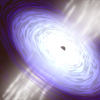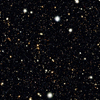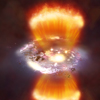CXC Home | Search | Help | Image Use Policy | Latest Images | Privacy | Accessibility | Glossary | Q&A
Animation of a Blob
Quicktime MPEG
This animation of a blob begins with a close-up view of a supermassive black hole in the center of a galaxy. Material falls into the black hole via a hot, rotating disk, and powers an outflow that pushes out into the galaxy. The view pulls back to show the galaxy hosting the black hole, as the outflow travels away from the galaxy and heats up surrounding gas. Several other outflows powered by the black hole are seen. The view pulls back even further to show the full extent of the gas in the blob containing the galaxy.
[Runtime: 00:30]
Quicktime MPEG
This animation of a blob begins with a close-up view of a supermassive black hole in the center of a galaxy. Material falls into the black hole via a hot, rotating disk, and powers an outflow that pushes out into the galaxy. The view pulls back to show the galaxy hosting the black hole, as the outflow travels away from the galaxy and heats up surrounding gas. Several other outflows powered by the black hole are seen. The view pulls back even further to show the full extent of the gas in the blob containing the galaxy.
[Runtime: 00:30]
(Credit: NASA/CXC/A.Hobart)
Images of Blob in Early Universe
Quicktime MPEG
This sequence shows two of the 29 blobs of hydrogen gas observed by Chandra in this study. The view begins with a wide-field view of this patch of sky from the Subaru telescope and then zooms in for a closer look at the blobs in multiple wavelengths. Hydrogen gas in the blob that glows in optical light is colored yellow, while the galaxies in the region are seen in infrared and optical light (colored red and white). The Chandra data - shown in blue - reveal the presence of a growing supermassive black hole in these objects.
[Runtime: 00:30]
Quicktime MPEG
This sequence shows two of the 29 blobs of hydrogen gas observed by Chandra in this study. The view begins with a wide-field view of this patch of sky from the Subaru telescope and then zooms in for a closer look at the blobs in multiple wavelengths. Hydrogen gas in the blob that glows in optical light is colored yellow, while the galaxies in the region are seen in infrared and optical light (colored red and white). The Chandra data - shown in blue - reveal the presence of a growing supermassive black hole in these objects.
[Runtime: 00:30]
(Credit: Optical: NASA/ESA/STScI/IoA/S.Chapman et al. X-ray: NASA/CXC/Durham Univ./D.Alexander et al. Lyman-alpha Optical: NAOJ/Subaru/Tohoku Univ./T.Hayashino et al. Infrared NASA/JPL-Caltech/Durham Univ./J.Geach et al.)
Illustrations of Phenomena in the Blobs
Quicktime MPEG
This sequence is a pair of artist's representations that depict what is happening within the galaxies inside the blobs. In the first illustration, the supermassive black hole buried in the center of the galaxy is seen powering a massive two-sided outflow. This illuminates and heats the surrounding gas. The second illustration shows how the effects of star formation and death are also contributing to the blob's radiation. The combined effects, plus the black hole's bright radiation allow the blobs to be seen across billions of light years.
[Runtime: 00:10]
Quicktime MPEG
This sequence is a pair of artist's representations that depict what is happening within the galaxies inside the blobs. In the first illustration, the supermassive black hole buried in the center of the galaxy is seen powering a massive two-sided outflow. This illuminates and heats the surrounding gas. The second illustration shows how the effects of star formation and death are also contributing to the blob's radiation. The combined effects, plus the black hole's bright radiation allow the blobs to be seen across billions of light years.
[Runtime: 00:10]
(Credit: NASA/CXC/M.Weiss)
Return to Lyman Alpha Blobs (June 24, 2009)





